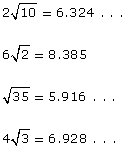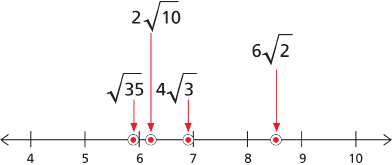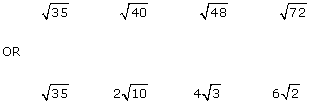Lesson 4: Mixed and Entire Radicals
Module 2: Roots and Powers
 Read
Read
Go to the textbook and work through the examples to further see how this is done. Pay attention to how the method is different from simplifying square roots.
Foundations and Pre-calculus Mathematics 10 (Pearson)
Read “Example 1: Simplifying Radicals Using Prime Factorization” on page 215 and “Example 2.b): Writing Radicals in Simplest Form” on page 216.
Example 1.a) is a reminder of how to use prime factors to simplify a radical with index 2. Example 1.b) and 1.c) show a similar method for simplifying radicals with index 3 and index 4. Example 2.b) demonstrates what happens in the case of a number with no perfect square factors.
You have learned to simplify entire radicals by converting them into reduced mixed radicals. There will be some cases, however, where it is helpful to do the opposite. Read the next example to see how you can convert mixed radicals into entire radicals.
Example 4
Write  as an entire radical.
as an entire radical.
Solution
What distinguishes an entire radical from a mixed radical is that the entire radical does not have a coefficient. So, the objective is to determine the value of the radicand.
Method 1: Perfect Square Factors
The number 2 can be written as 

Method 2: Prime Factorization
Remember that the coefficient of 2 came from a pair of 2s under the radical symbol.
Write 2 as 

Example 5
Write  as an entire radical.
as an entire radical.
Solution
Using the method of prime factorization, write 4 as 

 Read
Read
At this point, if you think you understand how to convert from entire radicals to mixed radicals and vice versa, proceed to the Self-Check. Otherwise go to the textbook and work through the next example for more help with this concept.
Foundations and Pre-calculus Mathematics 10 (Pearson)
Read “Example 3: Writing Mixed Radicals as Entire Radicals” on page 217.
How does the index help you to convert to an entire radical?
In the previous lesson you learned how to locate irrational numbers on a number line. In this lesson you have learned to convert mixed radicals to entire radicals. Both these concepts can be applied to the ordering of irrational numbers on a number line. Study the following example to see how each method is applied.
Example 6
Order these irrational numbers from least to greatest: 
Solution
Method 1: Number Line
Enter the radicals into your calculator to obtain a decimal approximation of each one.

Putting these on a number line will give you the correct order:

Method 2: Conversion to Entire Radicals
Convert each of the mixed radicals into entire radicals: 




Since each of the radicals has the same index, you only need to compare the radicands.
The correct order from least to greatest is

 Self-Check
Self-Check
SC 1. Simplify 
SC 2. Rewrite  as a mixed radical.
as a mixed radical.
SC 3. Express  as an entire radical.
as an entire radical.
SC 4. Convert  to an entire radical.
to an entire radical.
 Try This 3
Try This 3
Put your knowledge to the test by working through some of the questions from your textbook. When you are converting a mixed radical to an entire radical, pay attention to the index so you know how many factors of the coefficient you need to multiply with the radicand. When you are converting an entire radical, take an extra moment to make sure you have expressed the radicand as a product using the largest possible perfect square as a factor. This will help you avoid repeated multiplication.
Complete the following in your course folder ( binder).
Foundations and Pre-calculus Mathematics 10 (Pearson)
TT 3. Complete “Exercises” questions 4, 5, 11.a), 11.b), 11.c), 11.d), 12.a), 12.b), 12.c), and 12.d) on page 218.
Use the link below to check your answers to Try This 3.
Possible TT3 (Try This 3) Solutions
 Tips
Tips
It is really important to take a close look at the index before you work with a radical. If the index is not there, it is understood to be 2 (or the square root) and you are looking for one of two equal factors. If the index is 3 (the cube root), you are looking for one of three equal factors, and so on.